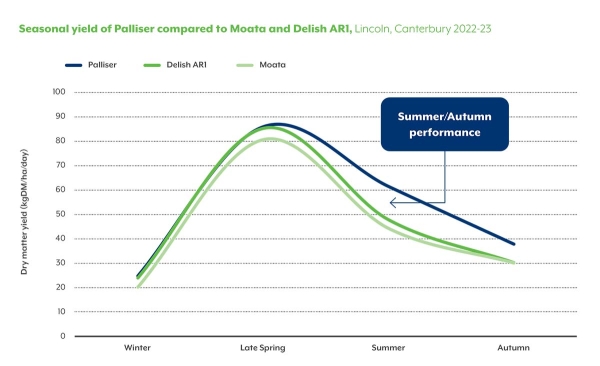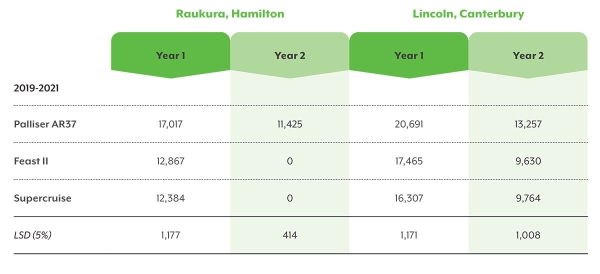Palliser
Tetraploid Long Rotation Ryegrass

- Can be used as either a short or long rotation ryegrass
- More rapid establishment than diploid types
- High dry matter yields throughout the year
- High palatability
- Excellent summer forage quality (very late flowering and low aftermath heading)
- Improved rust tolerance
- Ideal for undersowing pastures
- Benefits afforded by AR37 endophyte for insect protection
Palliser is a very late flowering (+25 days) tetraploid ryegrass with the flexibility to be used as a short or long rotation type. It is high yielding with strong summer and autumn production, high quality and persistence (AR37 endophyte) for a hybrid type ryegrass. Palliser was selected from elite plants created by a cross between tetraploid Italian and perennial ryegrasses with AR37. Palliser has strong rust tolerance and high tiller density, with a focus on plant survival under grazing. Palliser is best suited in high performance animal production mixes with clovers and herbs, adding cool season growth when used in mixtures with perennial ryegrasses or for repairing and under sowing pastures to extend longevity.
PURE STAND
22-28 kg/ha
SECONDARY COMPONENT OF MIX
7-14 kg/ha
UNDER SOWING
15 kg/ha
Dry Matter Performance

Palliser is extensively tested throughout New Zealand, including National Forage Variety Trials and regional and on-farm trialling. Summer and autumn dry matter performance is a strong characteristic of Palliser and reflects a ryegrass that is very late flowering and a long rotation type.
Sowing and Establishment
Palliser seed is heavier than diploid seed, so ideally should be sown at a 40% higher rate than diploid cultivars. Sow at a minimum of 22 kg/ha in a mix with clovers and herbs or can be added to a perennial mix with Base and Vast tetraploid perennial ryegrasses to increase shoulder season growth. These rates could vary from 7 to 14 kg/ha depending on the circumstances in which the mix is proposed to be used. In an under sowing situation, sow Superstrike® treated seed at 15 kg/ha. Palliser performs best on soils with reasonable soil moisture and medium to high soil fertility.
- Pasture Life 2 - 5 years
Trial Results

Annual dry matter yield performance (kg DM/ha) at two regional sites, Ruakura, Hamilton and Lincoln, Canterbury both showed the strong performance of Palliser over two full seasons of production following sowing in the autumn of 2019.
Feed Quality
Improving animal performance and production are benefits of tetraploid ryegrasses such as Palliser; and these are driven by higher palatability, increased animal intake, higher feed value and improved clover content. However, Palliser takes this tetraploid benefit a step further, especially in the summer/autumn period. Very late flowering ryegrass at 25+ days (relative to Nui at 0, this occurs about the 20th October), with improved rust tolerance and low aftermath heading means quality is comparable to tetraploid perennial ryegrass. On-farm this means Palliser offers plenty of options to integrate into systems, as either a grazing or conserved feed option.
GRAZING MANAGEMENT
As with all grasses, overgrazing of Palliser should be avoided. Given the higher palatability of Palliser, stock may graze it to lower residuals than diploid cultivars to ensure post-grazing targets are adhered to.



